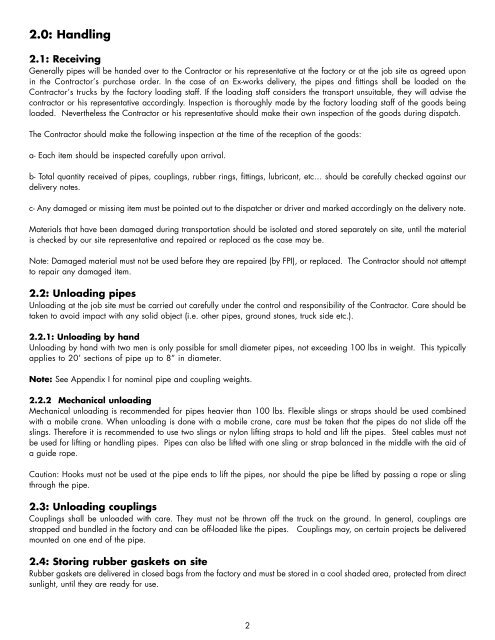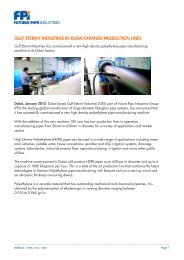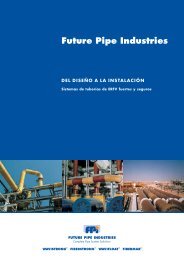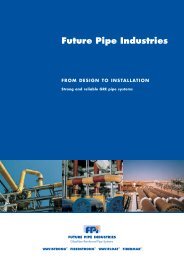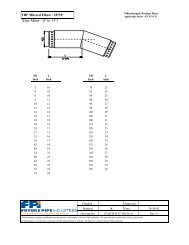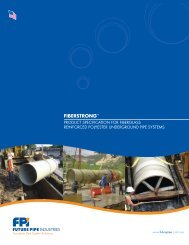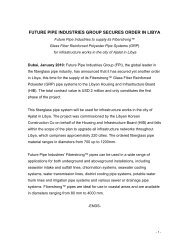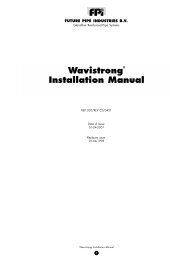Untitled - Future Pipe Industries
Untitled - Future Pipe Industries
Untitled - Future Pipe Industries
Create successful ePaper yourself
Turn your PDF publications into a flip-book with our unique Google optimized e-Paper software.
2.0: Handling<br />
2.1: Receiving<br />
Generally pipes will be handed over to the Contractor or his representative at the factory or at the job site as agreed upon<br />
in the Contractor’s purchase order. In the case of an Ex-works delivery, the pipes and fittings shall be loaded on the<br />
Contractor’s trucks by the factory loading staff. If the loading staff considers the transport unsuitable, they will advise the<br />
contractor or his representative accordingly. Inspection is thoroughly made by the factory loading staff of the goods being<br />
loaded. Nevertheless the Contractor or his representative should make their own inspection of the goods during dispatch.<br />
The Contractor should make the following inspection at the time of the reception of the goods:<br />
a- Each item should be inspected carefully upon arrival.<br />
b- Total quantity received of pipes, couplings, rubber rings, fittings, lubricant, etc… should be carefully checked against our<br />
delivery notes.<br />
c- Any damaged or missing item must be pointed out to the dispatcher or driver and marked accordingly on the delivery note.<br />
Materials that have been damaged during transportation should be isolated and stored separately on site, until the material<br />
is checked by our site representative and repaired or replaced as the case may be.<br />
Note: Damaged material must not be used before they are repaired (by FPI), or replaced. The Contractor should not attempt<br />
to repair any damaged item.<br />
2.2: Unloading pipes<br />
Unloading at the job site must be carried out carefully under the control and responsibility of the Contractor. Care should be<br />
taken to avoid impact with any solid object (i.e. other pipes, ground stones, truck side etc.).<br />
2.2.1: Unloading by hand<br />
Unloading by hand with two men is only possible for small diameter pipes, not exceeding 100 lbs in weight. This typically<br />
applies to 20’ sections of pipe up to 8” in diameter.<br />
Note: See Appendix I for nominal pipe and coupling weights.<br />
2.2.2 Mechanical unloading<br />
Mechanical unloading is recommended for pipes heavier than 100 lbs. Flexible slings or straps should be used combined<br />
with a mobile crane. When unloading is done with a mobile crane, care must be taken that the pipes do not slide off the<br />
slings. Therefore it is recommended to use two slings or nylon lifting straps to hold and lift the pipes. Steel cables must not<br />
be used for lifting or handling pipes. <strong>Pipe</strong>s can also be lifted with one sling or strap balanced in the middle with the aid of<br />
a guide rope.<br />
Caution: Hooks must not be used at the pipe ends to lift the pipes, nor should the pipe be lifted by passing a rope or sling<br />
through the pipe.<br />
2.3: Unloading couplings<br />
Couplings shall be unloaded with care. They must not be thrown off the truck on the ground. In general, couplings are<br />
strapped and bundled in the factory and can be off-loaded like the pipes. Couplings may, on certain projects be delivered<br />
mounted on one end of the pipe.<br />
2.4: Storing rubber gaskets on site<br />
Rubber gaskets are delivered in closed bags from the factory and must be stored in a cool shaded area, protected from direct<br />
sunlight, until they are ready for use.<br />
2


